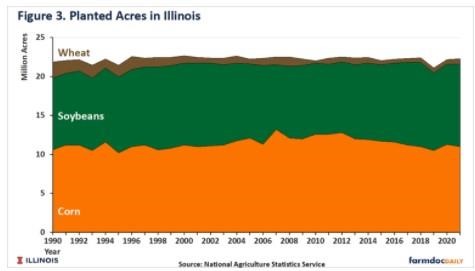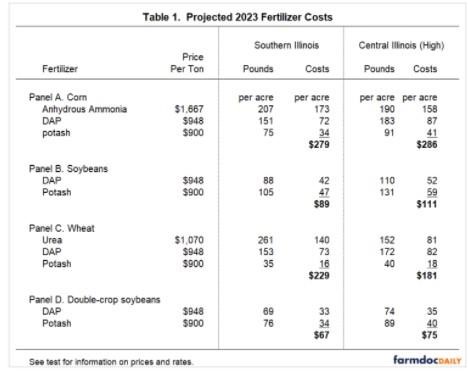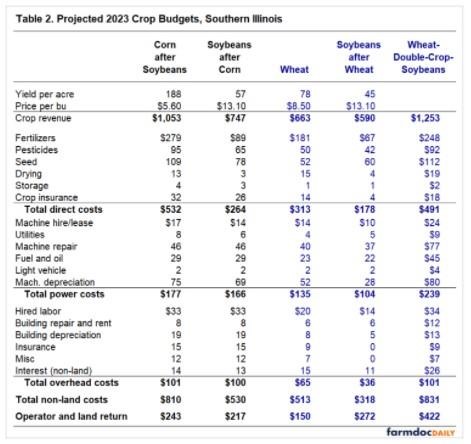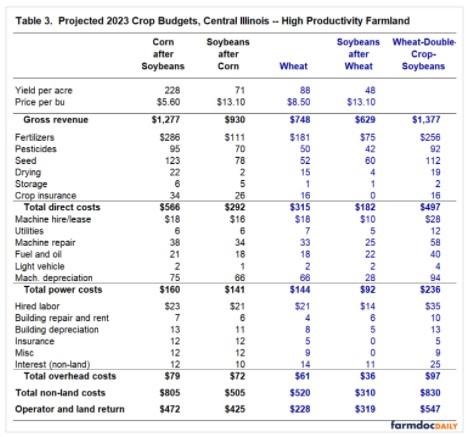By Gary Schnitkey and Krista Swanson et.al
Department of Agricultural and Consumer Economics
University of Illinois
Carl Zulauf
Department of Agricultural, Environmental and Development Economics
Ohio State University
The Ukraine-Russia war has resulted in much higher wheat prices as both Ukraine and Russia are significant exporters of wheat. As a result, some Illinois farmers may be considering planting wheat for harvest in 2023. In southern Illinois, budgets using 2023 harvest-time bids indicate that wheat-double-crop-soybeans are expected to be more profitable than stand-alone corn and soybean. Similarly, wheat-double-crop-soybeans are projected to be more profitable on high-productivity farmland in central Illinois. As a result, considering planting wheat for the 2023 harvest has merit. Still, wheat-double-crop-soybeans have challenges, and much can change between now and when decisions finally need to be made.
Wheat Background
Wheat acres in the U.S. have been declining since the 1990s. Planted wheat acres average of 72 million acres in the early 1990s, falling to an average of 45 million in 2019, 2020, and 2021 (see Figure 1). Corn and soybean acres increased since the 1990s, more than offsetting the decline in wheat acres.

Changes in demand partially explain these acreage shifts. The ethanol built from the mid-2000s to the mid-2010s spurred corn demand. Soybean exports have continued to grow throughout much of this period. On the other hand, the primary uses of wheat are in bread and other bakery products, which has generally been stable. Furthermore, corn and wheat are energy sources in livestock diets, and corn has increasingly filled this need.
The timing of wheat planting varies by geography and wheat classes. Some wheat classes are planted in the spring, including hard red spring wheat and durum wheat. Hard red spring wheat is used to make bread, while durum wheat often is used to make pasta. These kinds of wheat are grown in the northern Great Plains (see Figure 2). The Ukraine-Russia conflict happened before spring wheat planting commenced, leaving the possibility of increased spring wheat acres in 2022. Whether farmers choose to increase 2022 spring wheat plantings is an open question. Most planting decisions likely were made before the conflict began and adjusting planting decisions could be difficult. Furthermore, the profitability of corn and soybeans — the most likely alternatives to wheat — are projected to be profitable in 2022.

Winter wheat is planted in the fall and harvested the following summer. Given the planting schedule, harvested acres in 2022 cannot increase as these winter wheat plantings have already occurred. Winter wheats are planted over a large portion of the U.S. (see Figure 2). Two types of winter wheats predominate. Hard red winter used in making bread is grown in the Great Plains. Soft red winter wheat — usually used to make cakes, cookies, and crackers — is grown east of the Mississippi, including Illinois.
Similar to the U.S., wheat acres in Illinois have declined since the 1990s (see Figure 3). In 1990, 2 million acres of wheat were planted in Illinois. In recent years, less than 1 million acres of wheat have been planted. Total acres reported for 2022 are 730,000 acres.

Most of the wheat grown in Illinois is grown in southern Illinois. Washington County is the largest wheat-producing county, having 81,900 acres in 2022. All counties with over 20,000 acres are in southern Illinois: Randolph (38,000 acres), Clinton (35,500), Perry (33,300), Monroe (25,900), St Clair (22,000), Wayne (21,000), and Franklin (20,800). Indeed, seeing a wheat field in many northern and central Illinois counties is unusual.
In Illinois, a double-crop soybean crop typically is attempted with a wheat crop. A stand-alone wheat crop almost always is not as profitable as corn or soybeans.
Fertilizer Costs
Fertilizer costs will play a key role in the relative profitability of corn, soybeans, and wheat in 2023, and a great deal of uncertainty exists concerning fertilizer prices. Table 1 shows estimates of fertilizer costs for crops grown in southern Illinois and on high-productivity farmland in central Illinois.

Per acre costs shown in Table 1 are based on:
- Fertilizer prices were adjusted up 10% from the prices in the March 24th Illinois Production Cost Report: $1,515 per ton for anhydrous ammonia, $892 per ton for urea, $862 for Diammonium Phosphate (DAP), and 818 for potash. Increasing prices assumes that the sanctions resulting from the Ukraine-Russia conflict will be long-lasting and result in higher prices.
- Nitrogen requirements for corn were derived by consulting the Corn Nitrogen Rate Calculator. Wheat nitrogen rates come from consultations of the Illinois Agronomy Handbook.
- DAP and potash application rates are at replacement rates specified in Nafziger (September 7, 2017) and the Illinois Agronomy Handbook.
Corn, Soybean, Wheat Prices
Harvest-time bids for 2023 are used: $5.60 per bushel for corn, $13.10 for soybean, and $8.50 for wheat. These prices are high compared to historical prices.
The wheat-to-corn price ratio is 1.51 (1.51 = $8.50 wheat price / $5.60 corn price). From 1950 to 2021, the wheat-to-corn price ratio averaged 1.30. Hence 1.51 indicates that the 2023 wheat bid is relatively high compared to the corn bid. A return to historical levels reduces the profitability of wheat relative to corn.
Southern Illinois
Table 2 shows the 2023 budgets for southern Illinois. Operator and land return is projected at $243 per acre for corn, $217 per acre for soybeans, and $150 per acre for wheat. For these stand-alone situations, wheat has lower profitability than corn and soybeans.

Double-crop soybeans have a return of $272 per acre. When combined with the $150 per acre return for wheat, the wheat-double-crop-soybeans combination has a return of $422, exceeding the return of both corn and soybeans.
From 2003 to 2021, operator and land returns from the corn, soybean, and wheat-double-crop-soybeans combination were:
Corn: $231 per acre,
Soybeans: $225 per acre,
Wheat-double-crop-soybeans: $224.
From a historical perspective, the 2023 projected wheat-double-crop-soybean return is relatively high compared to corn and soybeans.
Central Illinois Budgets for High-Productivity
Wheat-double-crop-soybeans typically are not grown on high-productivity farmland in central Illinois. Questions have increased in recent years about the possibility of growing wheat-double-crop-soybeans. Table 3 shows budgets for high-productivity farmland in central Illinois.

Operator and land returns are projected at:
Corn: $472 per acre
Soybeans: $425 per acre
Wheat: $228 per acre
Wheat-double-crop-soybeans: $513 per acre ($228 wheat + $285 double-crop soybeans).
Wheat-double-crop soybeans are projected as having higher returns than corn and soybeans in 2023. Note that the margins are close in central Illinois. A return to a 1.3 wheat-to-corn ratio resulting in a $7.28 wheat price, would result in wheat-double-crop-soybeans having a lower return than the $472 per acre for corn.
Commentary
Wheat-double-crop-soybeans are projected to be more profitable than either corn or soybeans in 2023. Much can change between now and when wheat planting decisions occur. These budgets suggest that considering wheat in 2023 is reasonable, particularly in southern Illinois.
Still, making wheat-double-crop-soybeans profitable requires management. Generally, Illinois farmers have been moving to an intensive management system that involves fungicides. Harvesting wheat early at relatively high moisture is key to maintaining wheat quality and planting double-crop soybeans in a timely fashion. Of course, planting soybeans in late June/early July involves weather risks, and occasional low yields should be expected for double-crop soybeans.
Farmers without wheat-double-crop-soybeans should consider the learning curve associated with new systems. The profitability of a management practice or system usually increases with experience. Hence, those farmers with a longer run interest in wheat-double-crop-soybeans likely will find potential 2023 returns more motivating.
Wheat-double-crop-soybeans has both environmental benefits and rotational considerations. The wheat will act like a cover crop, which has the potential to reduce nitrates leaving the fields. Often, rotational studies find that including nitrogen will increase subsequent corn yields.
Planting wheat in 2023 could require changes to 2022 production practices on corn and soybeans. Generally, the optimal time to plant wheat is in late September through October, depending on the region of Illinois. Therefore, planting hybrids and varieties that facilitate making this window could be beneficial. Herbicide programs also could impact the advisability of fall wheat planting.
Wheat’s highest and best uses are in making bread and bakery products. Competing with corn in livestock feeds will result in downward price pressures on wheat. Large increases in wheat acres could result in downward price pressures on wheat.
Even given today’s prices, we do not find wheat as a stand-alone crop as a profitable alternative. Hence, consideration of only planting wheat likely will not result in higher returns.
Source : illinois.edu